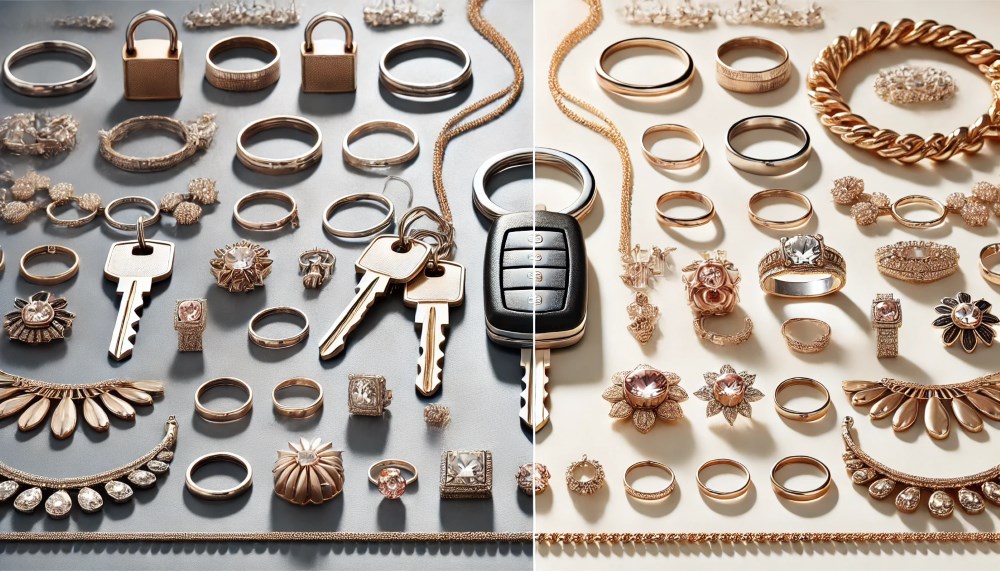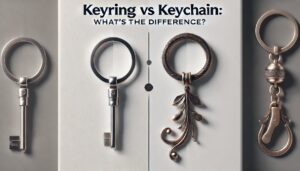Keyrings
Do Keychains Count as Jewelry?
When we think about jewelry, images of sparkling necklaces, elegant earrings, and dazzling rings often come to mind. But what about those everyday items we carry with us, like keychains? Do keychains count as jewelry? This question might seem simple at first, but a closer look reveals a fascinating exploration into the world of accessories, adornment, and personal style. This article will delve into the heart of this query, examining the definitions, cultural perspectives, and evolving nature of both jewelry and keychains to uncover the surprising truth about if do keychains count as jewelry.
What Exactly is Jewelry? Defining the Sparkle
To understand if keychains can be considered jewelry, we first need to define what jewelry actually is. At its core, jewelry is typically understood as decorative items worn for personal adornment. This definition highlights a few key aspects. Firstly, jewelry is decorative. Its primary purpose isn’t functional in the same way a tool or utensil is. Instead, it serves to enhance appearance and add aesthetic appeal. Secondly, jewelry is worn. This implies a direct connection to the body, usually attached to clothing or directly to the skin. Think of bracelets encircling wrists, necklaces draped around necks, or earrings adorning ears. So, considering these points, do keychains count as jewelry based purely on this initial definition?
Historically, jewelry has been crafted from a wide range of materials. Precious metals like gold, silver, and platinum are commonly associated with fine jewelry. Gemstones, including diamonds, rubies, sapphires, and emeralds, add color and brilliance. However, jewelry can also be made from less expensive materials. Beads, glass, wood, and even plastic can be fashioned into decorative pieces. The material itself doesn’t solely dictate whether something is jewelry. The intent and purpose behind its creation and use are equally important. Jewelry often carries cultural and symbolic meaning. It can represent status, wealth, belonging, or personal beliefs. Engagement rings symbolize commitment, while religious pendants express faith. Across different cultures and throughout history, jewelry has played diverse roles in social rituals and personal expression.
Keychains: More Than Just Keys? Exploring Function and Form
Now let’s turn our attention to keychains. At their most basic level, keychains are functional items designed to hold keys together. Their primary purpose is organizational and practical. They prevent keys from getting lost and make them easier to carry and manage. Imagine fumbling through a bag of loose keys – a keychain neatly groups them together, making life much simpler. Traditionally, keychains were simple rings or short chains made of metal. Their design was purely utilitarian, focused on their function rather than aesthetics. However, the evolution of keychains has seen them transform far beyond their purely practical origins. Therefore, considering their evolution, we should rethink, do keychains count as jewelry?
Modern keychains come in a vast array of styles, materials, and designs. Beyond simple metal rings, you can find keychains made from leather, fabric, plastic, and even precious metals. They feature charms, pendants, and decorative elements of all kinds. Think of keychains shaped like cartoon characters, animals, miniature objects, or adorned with logos and brand names. Many keychains incorporate personalization, allowing for engraved names, initials, or meaningful symbols. This shift towards decorative and personalized keychains blurs the lines between mere functionality and aesthetic appeal. They are no longer just tools for managing keys; they can also be expressions of personality and style. The keychain has evolved from a purely utilitarian object into something that can reflect individual tastes and interests.
The Blurring Lines: Where Function Meets Fashion in Accessories
The interesting point in our discussion is where keychains and jewelry begin to overlap. While the core purpose of a keychain is functional and jewelry is decorative, the modern reality shows these categories are not always distinct. Many keychains today incorporate elements that are undeniably decorative. Consider a keychain made of sterling silver with a delicate charm adorned with crystals. This object serves the practical purpose of holding keys, but its materials and design are clearly intended to be visually appealing. The use of precious materials and decorative embellishments moves it closer to the realm of jewelry. Thus, the question of do keychains count as jewelry becomes even more complex.
Furthermore, keychains are often used as accessories to bags and purses. They are attached to zippers, handles, and straps, serving as decorative additions to these items. In this context, the keychain’s function of holding keys becomes secondary to its role as an adornment. Think of designer keychains sold by high-fashion brands. These items, often priced as luxury goods, are clearly intended to be both functional and fashionable. They signal style and status, much like traditional jewelry pieces. The line becomes even more blurred when considering that some jewelry pieces can also have a functional element. For example, a watch, while primarily functional for telling time, is widely considered jewelry due to its decorative designs and use of precious materials. Similarly, decorative brooches can fasten clothing while also adding aesthetic flair. This interplay of function and fashion makes defining the boundary between keychains and jewelry more complex than it initially seems.
Functionality vs. Adornment: The Core Distinction and Grey Areas
Despite the overlapping elements, a key distinction remains between the primary purpose of keychains and jewelry. Jewelry’s raison d’être is adornment. Its main function is to enhance appearance, express personal style, or carry symbolic meaning. Functionality, if present, is secondary. Keychains, on the other hand, are fundamentally functional items. Their primary role is to organize and carry keys. While they can be decorative and expressive, their core purpose remains practical. This difference in primary purpose is a key factor in differentiating the two categories. However, when considering highly decorative keychains, we still must ask: do keychains count as jewelry?
However, this distinction isn’t always clear-cut. Consider a highly decorative keychain made with expensive materials, worn prominently on a handbag as a style statement. Is it still solely a keychain, or has it crossed over into the territory of jewelry? The answer likely depends on individual perception and context. For some, the functional aspect of holding keys might still be the defining characteristic, regardless of its decorative features. For others, the visual impact and stylistic intent might outweigh the functional aspect, leading them to perceive it as a form of jewelry or at least a jewelry-adjacent accessory. The grey area arises from the subjective nature of how we define and categorize objects based on both their function and aesthetic qualities. Personal interpretation and cultural context play a significant role in this categorization when we consider if do keychains count as jewelry.
Cultural and Personal Perspectives: How We Perceive Accessories
Cultural and personal perspectives significantly shape how we categorize items like keychains and jewelry. Different cultures may have varying understandings of what constitutes jewelry and adornment. In some cultures, elaborate keychains might be commonly used and perceived as decorative accessories, blurring the lines with jewelry more readily. In others, a stricter distinction might be maintained between functional items and purely decorative ones. Personal style also plays a crucial role. An individual who favors minimalist aesthetics might view any decorative element on a keychain as crossing into the realm of jewelry-like accessories. Conversely, someone with a more maximalist style might readily embrace highly embellished keychains as part of their overall look, seeing them as akin to jewelry. So, cultural context is vital when determining, do keychains count as jewelry.
Moreover, individual intent behind using a keychain can influence its perceived categorization. If someone chooses a specific keychain primarily for its aesthetic appeal, consciously selecting it to complement their outfit or express their personality, they are treating it more like a piece of jewelry. If, however, the selection is driven purely by practical considerations, with little regard for its appearance, it remains firmly in the category of a functional item. The perception and categorization are ultimately influenced by a combination of cultural norms, personal style, and individual intent. There isn’t a single, universally agreed-upon answer to whether keychains count as jewelry, as it depends on these subjective viewpoints.
The Materials Argument: Do Precious Materials Elevate a Keychain?
The materials used in crafting a keychain also contribute to the debate of whether they can be considered jewelry. As mentioned earlier, jewelry is often associated with precious materials like gold, silver, platinum, and gemstones. When keychains are made using these materials, does it elevate them closer to the category of jewelry? A keychain crafted from 18-karat gold, adorned with diamonds, undeniably carries a different connotation than a simple plastic keychain. The use of precious materials suggests a higher value and a greater emphasis on aesthetic appeal. It implies a level of craftsmanship and design that aligns more closely with traditional jewelry. This brings us back to the central question: do keychains count as jewelry when made with such materials?
However, material alone is not the definitive factor. A simple gold band might be considered jewelry, but a gold paperclip, despite being made of the same precious metal, is unlikely to be categorized as such. The design, intent, and context of use are equally important. While using precious materials can certainly imbue a keychain with a more jewelry-like quality, it doesn’t automatically transform it into jewelry. It contributes to the blurring of lines, but the core functionality and overall perception still play crucial roles. The presence of expensive materials can certainly strengthen the argument for a keychain being considered a form of jewelry-adjacent accessory, especially when combined with decorative design and stylistic intent.
Modern Keychains and Fashion Trends: Embracing the Accessory Spectrum
Modern fashion trends further complicate the distinction between keychains and jewelry. Designer brands are increasingly incorporating keychains into their accessory lines. Luxury keychains, often featuring iconic logos and distinctive designs, are marketed as fashionable items alongside traditional jewelry pieces. These high-end keychains are often displayed in jewelry sections of department stores and boutiques, further blurring the lines. Fashion influencers and style icons often incorporate these designer keychains into their outfits, showcasing them as statement accessories. This integration into high fashion and popular culture reinforces the idea that keychains can indeed be viewed as part of the broader spectrum of accessories, potentially including jewelry. Considering this trend, one might strongly argue yes, do keychains count as jewelry.
The rise of personalized and customizable accessories also contributes to this trend. Consumers are increasingly seeking items that reflect their individual style and interests. Keychains, with their vast range of designs and personalization options, become a versatile tool for self-expression. They can be chosen to match outfits, reflect hobbies, or showcase affiliations. This emphasis on personal style and expression further pushes the boundaries of traditional categories, allowing items like keychains to occupy a space that straddles functionality, fashion, and even jewelry. The evolving landscape of fashion embraces a wider definition of accessories, where items once considered purely functional can now be stylish statements.
Practicality and Personal Style: Finding the Balance in Everyday Accessories
Ultimately, whether keychains count as jewelry remains a matter of perspective and interpretation. There isn’t a definitive yes or no answer. Instead, it’s more accurate to say that keychains can function as jewelry-like accessories, especially in their modern, decorative forms. While their primary purpose remains functional, their evolution has incorporated significant aesthetic and expressive elements. They occupy a fascinating space on the spectrum of accessories, bridging the gap between purely practical items and purely decorative ones. For some, a keychain will always be just a keychain – a tool for managing keys. For others, a carefully chosen, decorative keychain can be a subtle yet meaningful expression of personal style, functioning as a form of everyday adornment. Therefore, when you ask yourself do keychains count as jewelry, remember it’s all about perspective.
The beauty of accessories lies in their versatility and adaptability. They allow us to blend practicality with personal expression, incorporating elements of style into our daily routines. Keychains, in their diverse forms, perfectly exemplify this blend. They are functional necessities that can also be stylish additions to our lives. So, do keychains count as jewelry? Perhaps not in the strictest, traditional sense. But in the evolving world of fashion and personal expression, they certainly occupy a space where function and adornment intertwine, making them fascinating accessories that can, for many, feel like a touch of everyday jewelry.





